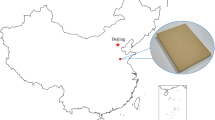Abstract
In this paper, thermal shock experiments at different temperatures and cycles were carried out on red sandstone. Its surface properties, including color and roughness, were systematically studied. The results show that the color change of sandstone is mainly related to two compositions: one is goethite, the other is calcium carbonate (CaCO3). The oxidation of goethite makes the sandstone redder, and the migration of CaCO3 makes it whiter. The sandstone is reddest at 550 °C and whitest at 700 °C. When the temperature is more than 550 °C, a white coat appeared on the surface of the sample. This process can be thought of as the migration of CaCO3 from the inside to the surface. The color parameters changed significantly around 550 °C and after 2, 3, and 4 cycles. The roughness variation of sandstone is not obvious due to not enough thermal shock cycles. The white coat can reduce the roughness of the sandstone to a small extent. The temperature of 550 °C is the critical threshold in this study which has important implications for red sandstone because it has a severe influence on the surface properties of red sandstone.









Similar content being viewed by others
References
Alonso, F. J, Vázquez, P, Esbert, R. M, Ordaz, J (2008) Ornamental granite durability: evaluation of damage caused by salt crystallization. Mater Constr 58:289–290
Chakrabarti B, Yates T, Lewry A (1996) Effect of fire damage on natural stonework in buildings. Construction & Building Materials 10:539–544
Dionísio A (2007) Stone decay induced by fire on historic buildings: the case of the cloister of Lisbon Cathedral (Portugal). Geological Society London Special Publications 271:87–98
Dionísio A, Braga MAS, Waerenborgh JC (2009) Clay minerals and iron oxides-oxyhydroxides as fingerprints of firing effects in a limestone monument. Appl Clay Sci 42:629–638
Dong Z, Sun Q, Ranjith PG (2019) Surface properties of grayish-yellow sandstone after thermal shock. Environ Earth Sci 78:420. https://doi.org/10.1007/s12665-019-8451-5
Gillhuber S, Lehrberger G, Goske J (2010) Fire damage of trachyte: investigations of the Tepla monastery building stones. Geological Society London Special Publications 333:73–79
Gómez-Heras M, Smith BJ, Fort R (2008) Influence of surface heterogeneities of building granite on its thermal response and its potential for the generation of thermoclasty. Environ Geol 56:547
Goudie AS, Allison RJ, Mclaren SJ (1992) The relations between modulus of elasticity and temperature in the context of the experimental simulation of rock weathering by fire. Earth Surface Processes & Landforms 17:605–615
Hajpál M (2002) Changes in sandstones of historical monuments exposed to fire or high temperature. Fire Technol 38:373–382
Hajpál M, Török Á (2004) Mineralogical and colour changes of quartz sandstones by heat. Environ Geol 46:311–322
Hall K, Lindgren BS, Jackson P (2010) Rock albedo and monitoring of thermal conditions in respect of weathering: some expected and some unexpected results. Earth Surface Processes & Landforms 30:801–811
Hall K, Meiklejohn I, Arocena J (2007) The thermal responses of rock art pigments: implications for rock art weathering in southern Africa. Geomorphology 91:132–145
Kompaníková Z, Gomez-Heras M, Michňová J, Durmeková T, Vlčko J (2014) Sandstone alterations triggered by fire-related temperatures. Environ Earth Sci 72:2569–2581
Kong B, Wang EY, Li ZH, Wang XR, Liu J, Li N (2016) Fracture mechanical behavior of sandstone subjected to high-temperature treatment and its acoustic emission characteristics under uniaxial compression conditions. Rock Mech Rock Eng 49:4911–4918. https://doi.org/10.1007/s00603-016-1011-3
Mahmoud MA, Nasr-El-Din HA, de Wolf CA (2015) High-temperature laboratory testing of illitic sandstone outcrop cores with HCl-alternative fluids. Spe Production & Operations 30:43–51. doi: Doi https://doi.org/10.2118/147395-Pa
McAllister D, Warke P, McCabe S (2017) Stone temperature and moisture variability under temperate environmental conditions: implications for sandstone weathering. Geomorphology 280:137–152. https://doi.org/10.1016/j.geomorph.2016.12.010
Mol L, Viles HA (2010) Geoelectric investigations into sandstone moisture regimes: implications for rock weathering and the deterioration of San Rock Art in the Golden Gate Reserve, South Africa. Geomorphology 118:280–287. https://doi.org/10.1016/j.geomorph.2010.01.008
Ozguven A, Ozcelik Y (2013) Investigation of some property changes of natural building stones exposed to fire and high heat. Constr Build Mater 38:813–821. https://doi.org/10.1016/j.conbuildmat.2012.09.072
Sarıcı DE (2016) Thermal deterioration of marbles: gloss, color changes. Construction & Building Materials 102:416–421
Sippel J, Siegesmund S, Weiss T, Nitsch KH, Korzen M (2007) Decay of natural stones caused by fire damage. Geological Society London Special Publications 271:139–151
Tian H, Kempka T, Xu NX, Ziegler M (2012) Physical properties of sandstones after high temperature treatment. Rock Mech Rock Eng 45:1113–1117. https://doi.org/10.1007/s00603-012-0228-z
Turkington AV, Paradise TR (2005) Sandstone weathering: a century of research and innovation. Geomorphology 67:229–253. https://doi.org/10.1016/j.geomorph.2004.09.028
Urban J (2016) The geological constraints of the development of sandstone landforms in Central Europe, a case study of the Swietokrzyskie (Holy Cross) Mountains, Poland. Geomorphology 274:31–49. https://doi.org/10.1016/j.geomorph.2016.09.014
Vázquez P, Acuña M, Benavente D, Gibeaux S, Navarro I, Gomez-Heras M (2016) Evolution of surface properties of ornamental granitoids exposed to high temperatures. Construction & Building Materials 104:263–275
Vázquez P, Luque A, Alonso FJ, Grossi CM (2013) Surface changes on crystalline stones due to salt crystallisation. Environ Earth Sci 69:1237–1248
Wang P, Xu JY, Liu SH, Wang HY (2016) Dynamic mechanical properties and deterioration of red-sandstone subjected to repeated thermal shocks. Eng Geol 212:44–52
Funding
This research is supported by the National Natural Science Foundation of China (Grant Nos. 41672279, 41807233); and the Natural Science Foundation of Jiangsu Province (Grant No. BK20180662).
Author information
Authors and Affiliations
Corresponding author
Ethics declarations
Conflict of interest
The authors declare that they have no conflict of interest.
Rights and permissions
About this article
Cite this article
Dong, Z., Sun, Q., Ye, J. et al. Changes in color and roughness of red sandstone at high temperatures. Bull Eng Geol Environ 79, 1959–1966 (2020). https://doi.org/10.1007/s10064-019-01678-w
Received:
Accepted:
Published:
Issue Date:
DOI: https://doi.org/10.1007/s10064-019-01678-w




